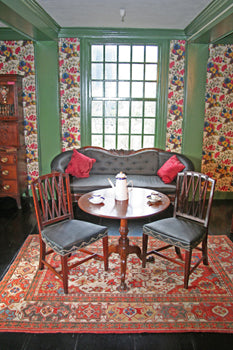
Oriental Rugs in a Historic Home: The House of the Seven Gables
20 - 07 - 2020Because of our store’s location, in an area rich in antique homes, we often supply Oriental Rugs to owners of historic properties. One of our more recent fascinating jobs was working with the curator of The House of Seven Gables in Salem, MA, to supply period-accurate rugs not far from our Salem store, the Turner-Ingersoll Mansion was built in 1668 by the wealthy merchant John Turner. The house is known popularly today for the novel of the same name by Nathanial Hawthorne, The House of Seven Gables. It is the oldest surviving seventeenth-century wooden mansion in New England. Opened up to the public in 1910, the property is on the National Register of Historic Places. For more detail about this marvelous house see: http://www.7gables.org.
The house itself was remodeled and restored over the centuries, and just as the house evolved, so too did the furnishings. With this in mind, the curator decided to furnish the rooms with period furniture and rugs from the mid 18th to mid 19th century. The original rugs from the 18th century were long gone, so the curator approached Landry & Arcari Oriental Rugs and Carpeting to help them find suitable antiques or reproductions of rugs in a style that would have been common in this period.
There was no documentation on exactly what sort of rugs were in the house originally. However, since the Turners were very wealthy at the time and both owned and dealt in fabrics from all over the world, we can assume that the family would have had access to the very best rugs. The curator concluded after research that Transylvania rugs would have been most appropriate for a wealthy home of this period. The museum gave us pictures of old Transylvania rugs that they wanted us to emulate and in consultation with the curator, we arranged for reproductions of three rugs in the Transylvania style to be made in Turkey for the museum.
The name itself for this style of rug is misleading, because the rugs most likely did not originate in Transylvania (region in northern Romania). They received their name because so many of them were discovered in the Lutheran churches of Transylvania. Rug scholars believe that most of these rugs were woven in Turkey and most likely ended up in the region due to trade throughout the Ottoman Empire.
The reproduction rugs that we had made for The House of Seven Gables are now on display in three rooms of the museum.

Here you can see a Transylvanian rug used in the parlor of the museum. Note how bright the wallpaper, paint, and rug colors are. The palette for this particular rug was developed to match the period accurate wallpaper.

The largest rug appears in the dining room. Again, note how the rug colors coordinate with the wallpaper. All of the wallpaper in The House of Seven Gables was based on the original paper which was found on the wall under centuries old layers of wallpaper and paint. The reproduction wallpaper itself was made using traditional techniques, as were the Transylvanian rugs that were woven by hand in Turkey, using natural plant dies just as a rug of the 18th century would have been made.

Finally, the museum commissioned us to have this smaller rug made for one of the house’s bedrooms. Original Transylvanian rugs can be found in museums and in important collections. We are also proud to offer a terrific contemporary copy of a Transylvania rug.





